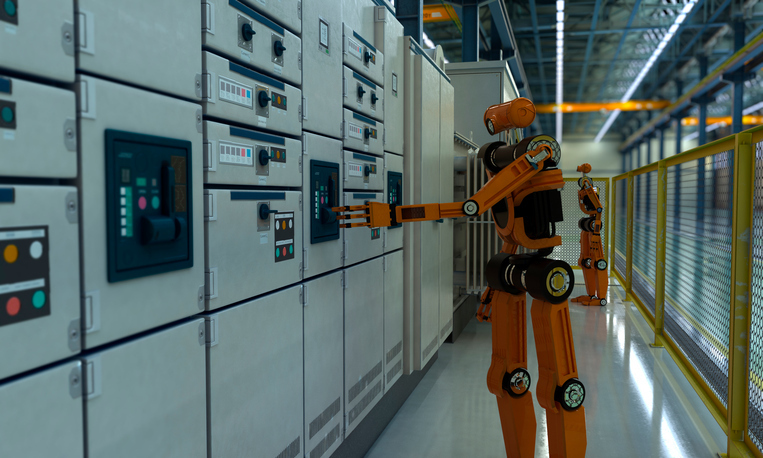Advice Note adopted by vote by the National Academy of Technologies of France (NATF)in Plenary session, July 5, 2017
In the framework of the Programme “A new industrial France” and with the perspective of seeing French robotics playing a key role in the re-industrialization of our economy with a restoral of national competitivity on the global market-place, the National Academy of Technologies of France (NATF) has analysed and presents herein a status report on French robotics. The Academy underscores the challenges the country must face and issues recommendations to reposition the French robotics sector in terms of international competition.
Current state: France is strong in research but weak in its industrial position
France ranks 4th in the world today for research in robotics, thanks to national infrastructure and the high quality training available. In contradistinction, France only comes 13th in terms of robot production, far behind Germany and Italy.
Moreover, industrial sectors in France are not sufficiently robotized; France has five times less working robots than Germany and twice less as Italy. France also lags behind American competitors in the field, and even more strikingly compared with Asian counties who are investing massively in robotisation of production equipment (30% growth of this market segment in China for 2016, with 68 000 units sold).
Current demand for urgently needed robotized equipment can only be satisfied by foreign suppliers. And yet there are companies at the cutting edge of robotic technologies which are strongly desirous to develop on both national and global markets. Their problem is to identify large industrial groups willing to the risks and play the role of integrators. The issue of integration is crucial in order to understand the robotics market-place since this phenomenon, alone represents one third of the necessary investments in robotics, inasmuch as when a robot is installed in an industrial setting, three components (each approx. with the same value) are needed: (1) the robot itself, seen as an integrated machine, (2) the robot’s specific software packages, (3) the integration proper of the robot in the existing production lines.
The challenges: providing a positive image of robots and protecting the national robotic ecosystem
The anti-robot tenets in France generate anxiety and misunderstandings for many people, disseminating negative ideas that can prove very destructive. To illustrate this point, the suggestion of a “robot tax” would be a catastrophe for the nascent French robotics sector, inasmuch it would represent a serious financial handicap faced with foreign competitors and would present a stumbling block for the French robotic industries. Without seeking to minimise the risks associated with robotic technologies, the public at large needs to have access to objective information as to the positive contributions robots can make to boost the external competitiveness for our economy as a whole, but also in relation to the training opportunities and possible job creations if a world-class robotic sector is instated.
In parallel, the American GAFA (acronym for all American, all tech giants, Google, Apple, Facebook, and Amazon) and their Chinese counterparts BATX (Baidu, Alibaba, Tencent and Xiaomi) who demonstrably have an irresistible appetite for robotics SMEs, ready to buy out emerging French companies in the field. What happens is that these companies cannot raise sufficient finance to cross the “valley of death” and develop, their products and finally they are absorbed as was the case for the French company Aldebaran acquired by the Japanese holding Softbank.
In order to resist external (and internal) pressure, the French robotics ecosystem is currently organizing itself to survive – adopting various ways to do this: the SYMOP robotics trade union (with intentional grouping of French SMEs or via the Occitanie Robotics regional cluster Robotics Place, which is setting up the French Federation of Robotics Clusters
Creation of a French robotics sector aspiring to take first place in the global market
France possesses all the ingredients to create a new French robotics sector capable of ranking #1 in the world. New sectors are opening to the possible uses of robotics and this leads to a sizeable increase in this market. A report entitled Key technologies 2020, produced by the French Ministry of Industry, with considerable input by NATF, estimates the global market turnover at 20 billion euros in 2020 (65% of which will operate in the service sector, and 12% in personal robotics). France State authorities must aid the entire national robotics sector to position itself on the global market-place and lead in the design and digitization breakthrough fields. Subsequently, NATF issues the following.
Recommendations:
– The integrators in French robotics should be helped and encouraged to assume risks faced with robotic needs of the French market, followed by those of the international markets;
– The financial circuits should be mobilized to support the implementation of a structured robotic ecosystem, with as the model what Aerofund has made possible for the aeronautical sector:
– SMEs active in robotics should be encouraged to organize independent networks, evolving in concerted manner, capable of defending themselves and with a better integrated offer;
– Advantage should be taken of the structuring role of the DGA [R&D division under the French ministry of Defence] in its capacity as a well-experienced, demanding client, with clear-cut needs in robotics that would enable it, if suppliers were found in France, to apply and
– maintain regulation compliance standards and strategic quality assurance (QA);
– efforts should be deployed in relation to robotics standards, just as France played a decisive role in standardizing the aeronautical sector in the 20th Century;
– The French robotics sector should be promoted both in the media and for the public at large and to support and encourage training for young people in this field, in particular at a regional level.

